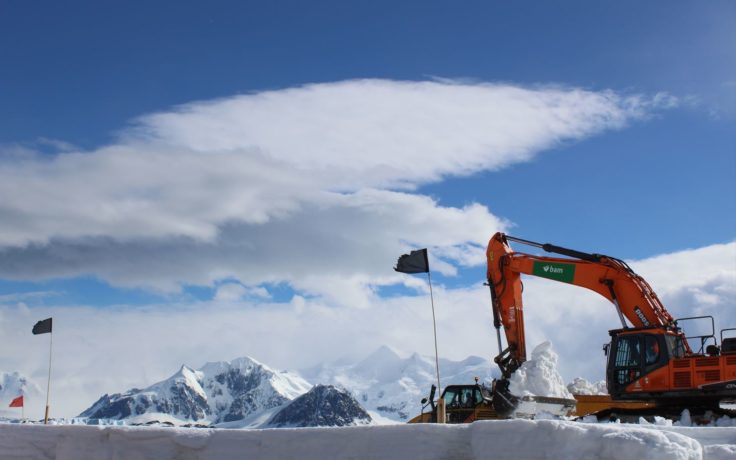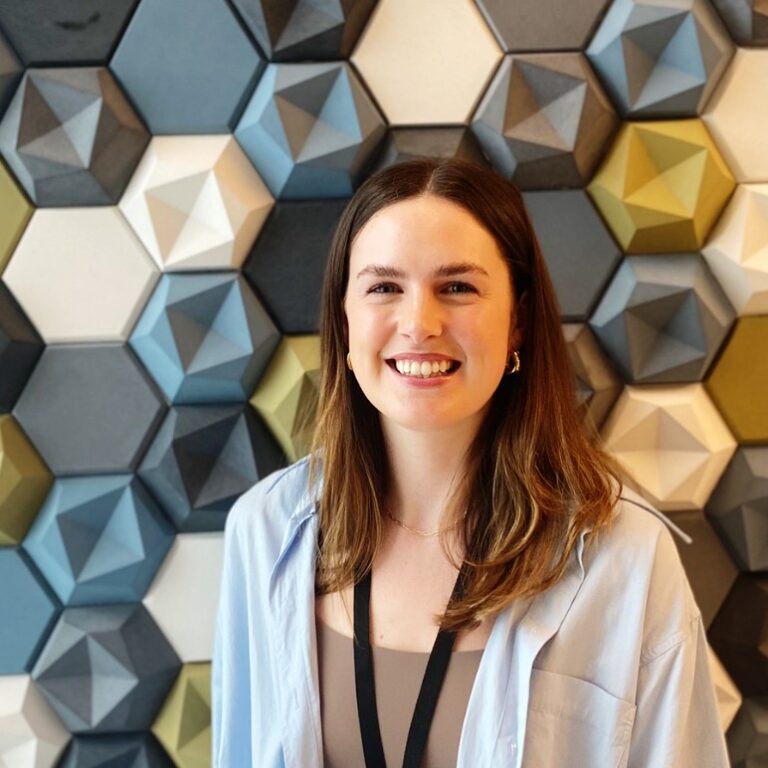
With below-freezing temperatures, high winds, and extreme dryness—not to mention its remoteness—there are few places less forgiving than the Antarctic. As the world's iciest continent, Antarctica holds most of the planet's freshwater in its ice sheets, meaning the region plays a crucial role in regulating the Earth's climate.
As such, it's critical to monitor conditions in the Antarctic to be at the forefront of climate, biodiversity, and ocean research. And The British Antarctic Survey (BAS) is on a mission to do just that—which is where the Antarctic Infrastructure Modernization Programme (AIMP) comes in.
AIMP is part of the long-term Government investment programme to modernise its research facilities in the Polar Regions, including six existing buildings that have reached the end of their life.
As David Brand, Senior Project Manager at BAS, explains, "AIMP ensures we can spend more time delivering science and spend fewer resources on building maintenance and logistics. With this project, we can enhance our science capabilities to better understand climate change during this crucial time in our lives."
Building sophisticated facilities in an extreme and remote location like the Antarctic is no easy feat, so the Natural Environment Research Council commissioned BAM, Ramboll, and Sweco for the project. With intelligent planning, next-level collaboration, and a "build it before we build it" approach, the teams successfully built and delivered a project in the harshest environment known to humankind.
AIMP consists of modernising several research stations (Signy Island, Bird Island, and King Edward Point) and the Rothera Research Station on the Antarctic Peninsula. Completed in 2021, the team had to remove the existing wharf in Rothera and construct a new one to support the latest polar research vessel, the RRS Sir David Attenborough.
In 2022, the team finished construction on the external skeleton of the Discovery Building, a new science and operations facility, and has plans to make the building weather-resistantand carry out airfield improvements on a 32-year-old runway in 2023.
“The coming construction season looks set to be our most complex and ambitious yet,” says Bruce Wulff, Framework Manager at Ramboll.
Throughout all of this, BAS, BAM, Sweco, and Ramboll have relied on a strong collaborative ethos to overcome seemingly insurmountable obstacles.
For starters, Antarctica is highly remote. Located about 15,000 kilometers from the BAS headquarters in Cambridge, coordinating all the logistics between the UK and the project site takes a lot of work.
"The distance presents several challenges for us, not only when getting personnel down to the top of the continent of the Antarctic, but also to plant the materials and equipment we need to deliver construction and science in the field," says David.
Beyond logistics, there's also the matter of costs and schedules.
"We're building something in the most isolated, remote part of the world. It takes a long time to get there," says Wulff. "It's costly to go back and fly a couple of bags of cement. Forgetting something is the last thing you want to do."
Small mishaps, like overlooking a few materials, can add weeks or months to the project, which could push critical on site work to the next building season.
Because Antarctica experiences six months of daylight during the summer and six months of darkness in winter, the teams have to set up their construction schedules accordingly.
"It's not just the cold that's challenging; it's also the amount of sunlight you get and the need to protect yourselves against solar radiation while working close to other people for a large part of the year," says David. "This presents a number of challenges you wouldn't normally experience back home."
It's also important to remember that Antarctica is a pristine environment, so teams must take measures to protect and preserve it.
According to Neil Irving, Digital Construction Manager at BAM Nuttall, everyone working on the project has been extremely vigilant.
"We must be very sensitive about our construction operations before we mobilise from the UK. We do an unprecedented amount of biosecurity checking. Every nook and cranny is inspected before it's loaded onto the vessel and before it's offloaded."
Another big challenge is capacity (or lack thereof) in the region. Given its remoteness, extreme weather conditions, and limited facilities, sending large teams to the Antarctic for extended periods of time is not ideal.
As Neil points out, "there's very limited bed space in Rothera. Therefore, we can only send a set amount of workers to the Antarctic. We can take maybe 50 or 60 members, and they all have individual duties on site."
The project presented one major challenge after another, but the teams behind it took everything in stride and completed the Rothera wharf in 2021.
They accomplished this through meticulous pre-planning activities and tight collaboration practices—all while using technology to tie everything together.
The project’s initiatives are rooted in a "build it before we build it" mindset, which essentially means planning and visualising every possible detail digitally and even physically before implementing them on-site.
"The approach we've taken with the Antarctic Construction Modernization Program is to build it before we build it. We built as much of the new infrastructure in the United Kingdom before shipping it down to the site," explains David.
This is particularly crucial when working in a distant and unpredictable environment like Antarctica. Again, the site is 15,000 kilometers away; the team must introduce certainty and predictability in every possible way.
"One of the main aspects of working in Antarctica is making things predictable and repeatable. So, we use digital tools as much as we can to rehearse the project before arriving on site," says Neil.
Tools like Revit and BIM 360 play a vital role, as they enable the project team to view the model in great detail and ensure they get it right before actually building and transporting everything halfway around the world.
According to David, the teams use Revit models for delivery, giving everyone a better understanding of what they need to build—and how to do it.
"The main benefit of this is that it helps us better visualise and picture what these buildings will look like and how we will operate within them. And from a project delivery point of view, Revit makes it easier to work through clashes between different design elements, so we can deliver better constructability and minimise waste," remarks David.
The team uses BIM 360 to manage equipment and materials and ensure they're on track with their sustainability KPIs. Biosecurity checks of materials and equipment are carried out at manufacturing and storage facilities before departure from the UK. Then upon arrival at the station, they're tracked in BIM 360.
Meanwhile, Sweco uses Autodesk Insight and Revit to power carbon-informed designs. As a result, they have saved 700 tons of whole-life carbon on the project thus far.
BAS, BAM, Ramboll, and Sweco display awe-inspiring levels of collaboration. The different teams do such an excellent job functioning as one unit that some folks can't distinguish which people work for which company.
"We've had suppliers in meetings with all four partners and remark that they actually can't tell who works for whom," comments Neil.
He adds, "It's refreshing to work on a project where everybody's pulling in the same direction, regardless of the company we work for."
Stewart Craigie, Technical Director at Sweco, echoes this. "The whole is greater than the sum of its parts. And that's quite a challenging thing to do because you need to find ways to get the teams to work effectively. Teams typically work well in the tribes, but we want to break the barriers between the tribes and make the whole team as one."
The teams can accomplish this mainly because everyone is focused on a common goal.
"What makes this partnership unique is the sheer determination of all partners working through the challenges together. That's what truly makes it quite remarkable; we're not taking any contractual positions, but rather what's in the best interest of all," says David.
This means bringing stakeholders into the project early to keep everyone in the loop. In the case of AIMP, Bruce says they work with contractors early on to ensure they're involved in the planning process.
"We've gotten very early involvement from the contractor. They are part and parcel of this design," says Bruce. "So when we are handing it over to them for final detailed design and construction, there are no surprises, and they can run with it very quickly."
Technology paves the way for a smooth process between teams by providing a common data environment (CDE) in which everyone can collaborate.
"With so many different partners working on the project and so many different engineers, it's imperative that we have a single model that everybody can relate to in real-time. So we're using BIM 360 models that we can pass from one design team to another seamlessly," says Bruce.
Through BIM 360, teams can stay on the same page and facilitate a smooth data flow.
Stewart notes, "We use BIM 360 because it gives us that collaborative way of working. It gives us joint access to the model and provides consistency, so we can create the models in a clear delivery sequence."
With BIM 360, the team can model, visualize, and coordinate their projects down to the smallest detail and verify the delivery of project and asset data—ultimately ensuring they're on the right track every step of the way.
The conditions that BAS, BAM, Sweco, and Ramboll faced in the Antarctic take the concept of a "construction challenge" to a new level. However, no challenge is too big when you have determined and dedicated team members that collaborate seamlessly—and are equipped with the right tools.
AIMP is undoubtedly a unique opportunity for teams to build something incredible and elevate their knowledge to take on more interesting challenges in the future.
As Stewart puts it, "The thing that makes me most proud is watching people join the team, growing the team, and then watching what opportunities they gain when they leave. We're prepared for people to come in and join us and then move on. But we see that when they're moving on, they're moving on as more developed people and getting bigger opportunities in the world."

May we collect and use your data?
Learn more about the Third Party Services we use and our Privacy Statement.May we collect and use your data to tailor your experience?
Explore the benefits of a customized experience by managing your privacy settings for this site or visit our Privacy Statement to learn more about your options.